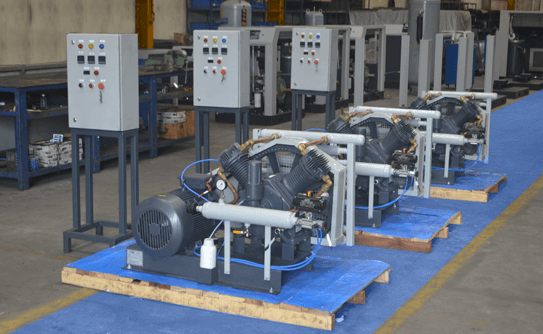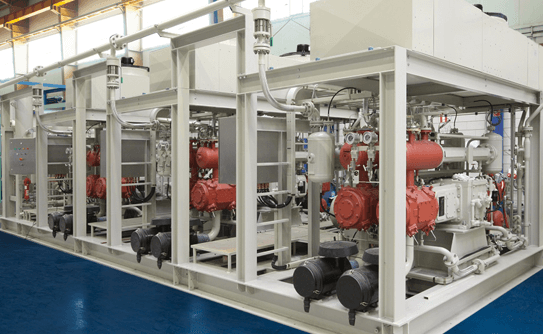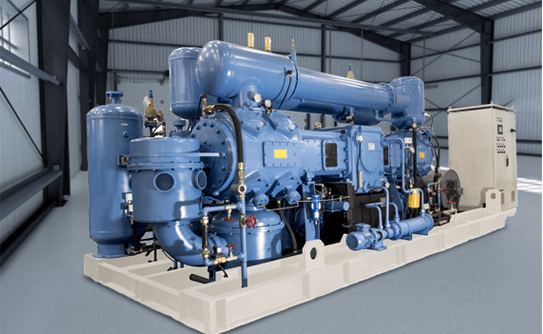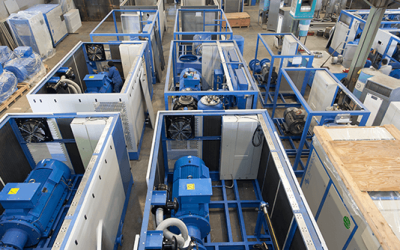Piston compressors should be considered the base of all modern compressors. These compressors work very similar to the combustion chambers of cars; with the difference that there is no spark or explosion at the moment of fluid compression and the compressed gas must be directed out from the outlet valve. To check reciprocating compressors, they can be checked separately. The compression action in a piston compressor is done with the help of reciprocating pistons inside the cylinder (which is actually the same compression chamber).
The number of these pistons is the main factor in determining the capacity of the compressor. The reciprocating movement of the pistons is linear. But the driving force that creates this linear movement is a crankshaft that has a rotational movement. The crankshaft is moved with the help of a main driver and goes through a circular movement. On the other hand, each piston is connected to the crankshaft with the help of connecting rods. In this way, the rotational movement of the crankshaft is converted into a linear and reciprocating movement of the pistons, and suction, compression and discharge operations are performed in piston compressors.
Compression in reciprocating compressors is done in three stages, which are as bellows:
- Suction
- Compression
- Discharge
See the following sketch:

Classification of reciprocating compressors:
Piston compressors can be classified according to performance or production capacity. First of all, this division is done in a single-stage or two-stage form.
If the state of the gas fluid is such that only one side of the piston is compressed, it is called a single-stage compressor.
If the design of the compressor is such that both sides of the piston can be used for gas fluid compression, it is called a double acting compressor. In this series of reciprocating compressors, the piston shaft and crosshead are used to move the piston. One end of the piston is connected to the piston shaft, and the other side of the piston shaft is connected to the connecting rod with a crosshead, and in this way, the reciprocating motion of the crankshaft is transferred to the piston.
See the following sketch:

Each of these compressors can in turn have two or more compression stages, which are usually supported by the intercooler cycle. In this case, in the first chamber, the gas fluid is compressed to relatively small amounts and after cooling in the next stages, it reaches its nominal pressure.
See the following sketch:

Other common classifications for reciprocating compressors are based on structure, capacity, and operating temperature.
Based on the structure:
- Open compressors: In open compressors, the motor and the compressor housing are separate from each other. Refrigerator compressors, for example, fall into this category.
- Semi-open compressors: the shell of these compressors is not completely closed and is assembled with screws and can be repaired in case of failure. High capacity compressors usually fall into this category.
- Closed compressors: Closed compressors cannot be repaired. In this series of compressors, the motor and housing are together. Small compressors are usually included in this category.
Based on capacity :
- Capacity less than 3.5 kW
- Small compressors: capacity from 3.5 to 23 kW
- Medium compressors: capacity from 23 to 105 kW
- Large compressors: capacity higher than 105 kW
Based on operating temperature:
- High temperature: compressors used for ventilation systems.
- Average temperature: refrigeration compressors up to the temperature above zero degrees Celsius
- Low temperature: refrigeration compressors for temperatures below zero degrees Celsius
Advantages of piston compressors :
- Compression range: piston compressors mainly have the ability to increase the pressure of gaseous fluids to high pressure ranges that cannot be achieved with other compressors such as screw or centrifugal.
- Variety of capacity: Since piston compressors can be produced with different capacities, they can be used in various applications, from the compression of process gases in petrochemicals to huge cold stores or small household refrigerators.
Major disadvantages of reciprocating compressors :
- Low efficiency
- Occupying large space and high weight
- High levels noise
- Maintenance costs
Advantages of choosing HATCO
When it comes to the advantages and benefits of reciprocating air compressors, we can offer customers more benefits than any other type of air compressor on the market. Although, every type of compressor has their own advantage and they are deployed in the industries based on that. Some of the advantages are given below.
- Designed for continuous duty
- Deep finned cast iron cylinder
- Low expansion aluminum alloy piston
- Forged steel crankshaft
- Sturdy, robust cast iron crankcase
- Optimal operating speed
- Aluminum cooler tubes and aerodynamically designed fan for efficient cooling
- Air receiver, conforming to ASME design
- Pressure relief valve for extra safety
- Automatic start and stop loop control










There are no reviews yet.